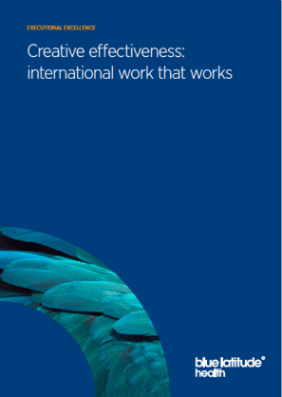Creative effectiveness: international work that works
July 19, 2017 | Brand Strategy, Customer Engagement, Multi-channel Marketing, creative, design
Creative Director Damien Parsonage explains how the creative department at Blue Latitude Health creates work that resonates with customers and delivers results.
When it comes to the creative department here at Blue Latitude Health, work that works is essentially ‘creative effectiveness’.
By that we mean practical, impactful brand engagements that deliver tangible results – both short and long term.
This requires utilising a variety of skills, techniques and experience to achieve the desired outcomes, which is why we have such a diverse, multi-disciplined creative department.
We come from a wide range of backgrounds, with senior experience in consumer and pharma, both above and below the line. We have expertise in advertising, design, direct response, sales promotion, video and film, experiential, and digital work. We understand how to make people feel something and do something – a powerful combination.
This is important because being able to push both emotional and rational buttons is crucial in pharmaceutical marketing.
Finding that global sweet spot
It can be notoriously tricky when doing global or even cross-regional work. In our capacity as both a global and regional agency of record, we’ve been on both sides of the fence.
We know how tough it can be to produce powerful international creative campaigns that resonate with clients and audiences worldwide.
Equally, we know how frustrating it can be to receive a weak or inappropriate global campaign to work with. So how do you satisfy everyone and deliver global work that works?
When we’re developing big concepts, we ask ourselves these questions:
1. Is it universal?
The very best ideas are usually simple and generally universal. If you’re going to have a campaign that appeals to the world, it’s best not to be overcomplicated or culturally narrow. So much work falls down by being too parochial or too clever (and therefore alienating).
That’s not to say you can’t have powerful ideas. They might not be as edgy as a purely local campaign could be, but there’s plenty that unites us as humans; tap into that and you’ll have something that stands up and stands out.
2. Is it flexible?
Can the idea work across multiple media? A great idea will be adaptable to different communication tasks, not just a press advertisement or a hero shot. How would it work in a conference setting? Is it strong digitally? If the key idea relies on a moving image, how will it work statically?
You don’t need to work out every eventuality; just do enough probing to prove that your idea can comfortably stretch to meet your most likely needs.
3. Is it functional?
In order to flourish as a proper brand campaign, your idea needs to have additional visual elements that complement the core concept and fall naturally from it.
Communications require more than just a hero shot. An idea may work well as a single execution, but can lack real depth or applicability. So ask yourself, does your concept lend itself to strong associated graphic or design elements? Can the idea extend into a distinctive visual language? In other words, can it function as a campaign?
Perhaps unsurprisingly, it can be easy to get overly pleased with finding a core idea that works globally. It can feel like a real ‘hallelujah!’ moment. And yet it’s not enough – you need more than just a core idea.
You’re trying to inspire local countries to embrace your work and roll it out effectively in their own markets, so you need to give them the tools to do that.
In the past, we’ve been presented with a single core picture as a global brand idea and expected to roll it out as a coherent campaign. Such half-formed thinking is not only frustrating, it’s almost a sure-fire way to hamper the effectiveness of your engagements.

Download the full article from Blue Latitude Health
This content was provided by Blue Latitude Health




